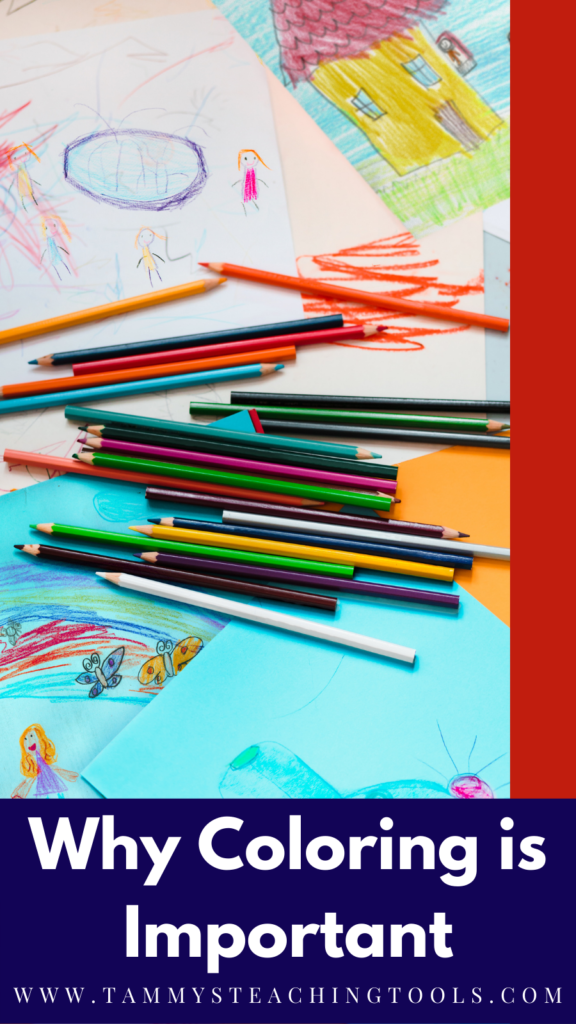WHY COLORING IS IMPORTANT FOR LEARNING
Did you know coloring is important for kids learning? I remember being in grade school and coming home with a coloring book. My mom would sit down with me and we would color together. It was a bonding experience for us, and I loved it. Now, I realize that coloring is important for kids, young and old.
Using color techniques and activities for teaching is very important for all types of learners. The use of colors can be used in many ways, from the youngest student to the oldest. Keep reading, and I will show you the benefits of adding color to your routines in the classroom.
Why coloring is important for younger students
Coloring can do more than just teach the names of colors in a fun and tactile way. Coloring and drawing improve fine motor skills, encourages focus, and promote creativity. The actions and specific grip involved in coloring can support the development of the fingers, hands, and wrist muscles. This can create better handwriting as this skill progresses. Holding crayons, choosing colors, and applying the color on paper can all help with building hand-eye coordination. Coloring (and drawing) can build on imagination and influence young students to think of new ideas on their own naturally.
Coloring is a great sitting still activity. It encourages kids of all ages and activity levels to slow down and focus on one specific task. Setting aside a reasonable amount of time for a student to practice focusing on a specific task can improve this skill as they move forward in grades and skill levels.
Another example of why coloring in the classroom is essential is because some educational content might be too complex for our youngest learners’ comprehension. In this case, a coloring page that goes with the taught skill can be used to reinforce learning and could include self-paced, creative-expression activities. While we always seek to provide fun activities, the utmost purpose is to reinforce health and educational concepts with students in an engaging (and repetitive way).
Coloring isn’t always easy
Coloring also takes patience. Learning how to color inside the lines or draw a straight line isn’t easy. According to many Occupational Therapists, they see students that refuse to color. Other times they come across children that prefer markers over crayons. There are reasons for these underlying difficulties you should be aware of:
- Arch development (for endurance)
- Hand strength to move the crayon against a resistive surface
- Pinch and grip
- Precision to move the crayon with the fingers instead of the whole arm/wrist
- Line awareness/visual perceptual skills
Why using color is important for older students
The information mentioned above is also true for older students (promoting and continuing fine motor skills, eye-hand coordination, focusing, etc). However, we can go even further for older children when using color.
For years, marketing strategists have been connecting brands with certain colors so that their messages will stick in buyers’ minds (e.g., McDonald’s (yellow), Target (red), Home Depot (orange), etc.). Studies continue to demonstrate color as the most important visual experience to human beings.
 With that said, color coding is an essential differentiation strategy for all ages. Color coding is the concept of assigning different colors to indicate various tasks. This can be adapted for young and old students and even adults. This concept is very effective for this age group because there are more note-taking, test-taking, and organization needs. With a little planning, when purposefully implemented, color-coding can have a tremendous effect. This system also improves one’s recall and retention abilities.
With that said, color coding is an essential differentiation strategy for all ages. Color coding is the concept of assigning different colors to indicate various tasks. This can be adapted for young and old students and even adults. This concept is very effective for this age group because there are more note-taking, test-taking, and organization needs. With a little planning, when purposefully implemented, color-coding can have a tremendous effect. This system also improves one’s recall and retention abilities.
Another example of a color-coding strategy is selective highlighting. This strategy teaches students to highlight/underline ONLY the keywords, phrases, and vocabulary. Color-coding visual organizers are another way to support this concept. This strategy provides another layer of support for writing development because it clearly shows relationships between ideas and can assist students in distinguishing between concepts and ideas. Try to stick to three colors (or fewer) per lesson and keep it consistent!
❤️️ As an adult, you may know coloring is known to calm and be a therapeutic activity for adults. Did you know it is for students too? This is especially true if they have no other outlet for unpleasant or confusing emotions. Even kids who fall into the “normal” range of emotional health can benefit from processing their feelings through the simple but important act of coloring. From working on physical motor skills to helping with emotional expression, it is crazy how many things this simple activity does.
❤️️ Get started with some coloring pages here:
- Spring coloring pages
- Growth mindset coloring pages
- Phonics coloring pages
- Free Social-Emotional Activity Page and Coloring Sheets

Sign up for my e-mail list and get access to a resource library of coloring pages and other great activities that you can print and use with your kids today.
Have a colorful day!



